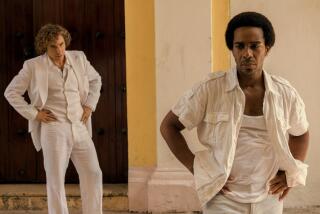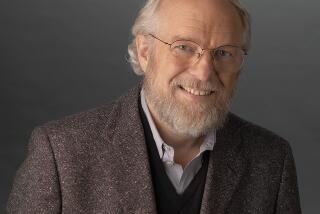‘Saint Peter’ : Gentle Software Genius Is Also a Benevolent Presence on the L.A. Art Scene
- Share via
It’s a personal computer user’s worst nightmare: You accidentally delete an entire file containing your life’s work and you’re certain it has disappeared forever.
Then someone whips out the Norton Utilities, a software package whose centerpiece is UnErase, a program that brings zapped masterpieces back from the dead.
In a matter of minutes, you and the epic are saved.
That’s why, when some people meet Peter Norton, they almost want to genuflect. Like the San Francisco journalist who gushed when they were introduced, “Last night, I met Rod Stewart at Morton’s. But that was nothing compared to meeting you.”
In all probability, Peter Norton blushed. The 43-year-old computing genius has amassed a multimillion-dollar personal fortune almost overnight through the sales of his software packages and books. He is perhaps the best-selling author in the field of personal computers. Everyone from the White House to the CIA to Fortune 500 companies are devoted users of his products.
Small wonder, then, that Norton has become known as the “Software Saint.”
Now, he’s well on his way to becoming a patron saint of the Los Angeles art community as well.
Last year, Norton and his wife, Eileen, pledged a third of a million dollars over three years to the Los Angeles Museum of Contemporary Art--enough to have a gallery named after them. Their donations to the little-known downtown Museum of Neon Art have put them on the board of directors and put Norton’s name in neon on the museum’s ceiling.
Non-Mainstream Groups
The Nortons’ support of such non-mainstream arts organizations as the Mural Conservancy, the planned Santa Monica Art Museum and the Santa Monica Arts Commission have been crucial, by all accounts, to the groups’ financial health.
And they donated two paintings to the traveling show “Hispanic Art in the United States” organized by the Corcoran Gallery in Washington.
“We try to find neglected causes. After all, we’re not the Ford Foundation, which can give away millions,” Norton explains. “Instead, we think, ‘Where would $10,000 make a difference?’ ”
He pauses a moment, realizing that he’s getting something in return. “If you’re cynical about this stuff, you can say I’m buying my way into glory,” he says. “And, to a certain extent, we do that. We are a little bit social-climbing. But it’s a lot of fun.”
Unlike many Southern Californians who suddenly come into money and immediately head to New York to buy internationally recognized artists, the couple have filled nearly all their 100-or-so-piece collection almost entirely with the works of homegrown painters and sculptors like Thermon Statom, Eric Orr, Robert Gil de Montes and Silvia Shap.
They invite the artists to dinner and to parties, visit their studios, commission special works, “and just generally get involved in their lives,” Norton explains. “In a certain small way we’re trying to husband the careers of a number of them.”
“It’s very commendable and very intelligent,” says Santa Monica portrait artist Don Bachardy, a neighbor who is represented in the Nortons’ collection.
“I hope this guy is the wave of the future,” says muralist Kent Twitchell, who was commissioned by the Nortons recently to adorn the outside of their home with a 13-foot portrait of Bachardy. “He’s like an up-and-coming benevolent factor within the L.A. art world.”
Exactly why Norton has carved out a career of do-goodism seems to mystify him as much as it impresses others. Is Norton, a quintessential yup with his standard-issue gray BMW with the vanity license plate MRIBMPC, merely an early incarnation of what the news mags are already calling the trend towards altruism? “Obviously, I’m a little bit of a strange duck,” he concedes.
More to the point, he’s what you might call, well, . . .
“ Oh ,” he shudders. “The N-word. I fit into the classic nerd category.”
With his washed-out blond looks, wimpy build and meek manner, Norton is well aware that he seems like a Central Casting version of a computer whiz, too stereotypical to be the real thing.
“I’ve tried to outgrow being intellectually withdrawn, something of a social misfit, the kind of kid who carries a slide rule--and I actually did. I can now talk about it with humor, but it was painful certainly then.”
Pure Ozzie and Harriet
Born and raised in Seattle, Norton describes his upbringing as pure Ozzie and Harriet. His father was an insurance sales executive, his mother a housewife. “I had one brother so we were the perfect nuclear family. But in my family and in my neighborhood, I was a weird kid.”
If personal computers had been around when he was a child, his best friends would have been IBM and Apple. Instead, he was a lonely kid and didn’t come into contact with a computer until the early 1960s, when he was a mathematics and physics major at Reed College in Oregon. During a summer job at an insurance company, “Someone said, ‘Here, boy, teach yourself how to work this machine,’ ” he recalls. “It was one of those love-at-first-sight things.”
Norton dropped out of college in 1965 while in the middle of his senior thesis. “I had an adolescent crisis right when I was supposed to be most effective intellectually. I just sort of fell apart,” he recalls. He was drafted into the Army for two years but managed to avoid being sent to Vietnam by being made a teacher of combat first-aid.
It turned out to be “the most incredibly satisfying job I could have had”--and his first introduction to do-goodism.
After the Army, he earned enough money to go back to college and graduate from UC Berkeley in 1969. For the next dozen years, he had a succession of computer jobs.
“If it were the 1880s and the Old West, I would probably have been called a drifter. Because until I founded my own company I’d never held down a job longer than two years,” Norton explains. “I was easily bored, restless and impatient. These are characteristics that don’t fit into stable situations very well.”
‘Totally Unsuited’
He tried free-lance consulting but “quickly discovered I was totally unsuited because you have to be really good with people.” He didn’t know what to do.
IBM solved the problem at the end of 1981 when it unveiled its personal computer and changed the face of the industry. Norton bought one almost as soon as it came on the market.
He wrote some programs strictly for his own amusement, and in the process lost some important data. “I knew enough about the machine to know that the data wasn’t absolutely lost. It was simply discarded. But I couldn’t reach into the wastebasket and get it back.
“I thought to myself, ‘I don’t want to ever do this to myself again.’ So I wrote a program that would, metaphorically speaking, let you rummage through the wastebasket and let you get back the stuff you’ve thrown away.”
He also wrote a few other programs to let IBM PC users better explore and understand their machines. Then he put them all together and packaged them under the name “Norton Utilities” and, with his life savings of $30,000, started his own software company.
While the programs were designed to help people, it was sheer selfishness that motivated him to market them. For one thing, he didn’t want to go back working for other people. For another, while most computer whizes like himself were writing nifty programs and just giving them away for free, “I decided to take the tack to see if I could make a living peddling this software.”
He smiles goofily. “I did a little more than make a living.”
By the end of 1982, he was about breaking even. Doubling every year after that, his gross sales in 1987 topped $12 million, Norton says.
Reputation as PC Guru
Almost immediately, Norton developed a reputation as a PC guru. He wrote dozens of articles for computer magazines and, eventually, a publisher approached him to write a book. Now, by his own estimate, there are a million copies of his more than dozen PC books in print. Like his software, they feature his photograph--arms folded, face fixed in a small smile, horn-rimmed glasses off--looking like the Mr. Clean of computers.
(Well, almost Mr. Clean. He risked jail when he ran ads boasting that his company was being used by the CIA--something the intelligence agency’s suppliers are prevented by law from doing. The attorney general slapped him with a cease-and-desist letter, and “we gave him a humble pie apology,” Norton says.)
There were similar data retrieval programs on the market for other computers, but as the popularity and profitability of the IBM PC grew, so did Norton’s. “I was simply lucky enough or smart enough, I don’t know which one, to choose the machine that was going to have a monster success in commercial and personal use.”
This winter, the firm--which started in a Venice condo--is moving to swank new digs at 100 Wilshire in Santa Monica with a panoramic ocean view.
But Norton remains an unorthodox entrepreneur. How many employees does he have? “I don’t know, and I run the joint,” he smirks. “I don’t have a big fancy office, and I don’t have a secretary.”
To hear him tell it, his success embarrasses him. “No, I’m not one of those hard-charging guys. I don’t want to be worth a billion instead of a couple of million,” he says. He lives comfortably, but “you won’t see any big pinkie rings. Flashy consumerism isn’t my style or my wife’s.”
Eileen, a former elementary schoolteacher, also came from a modest background. The daughter of a drugstore clerk and a postal worker, she grew up in Watts, graduated from UCLA and received a masters in bilingual education from USC. She and Norton met in 1981 when they answered each other’s personal ads in a dating magazine. They were married in 1983 and have a 5-month-old daughter, Diana.
‘Love at First Sight’
“Looking at his ad compared to someone else’s ad, I couldn’t tell you what attracted me,” she laughs. “But it was love at first sight when we met. It really was. What I like is that he’s nice. Nice .”
Eileen Norton “doesn’t understand” computers, she says, which is fine with her husband “because I get tired of computer shop talk.” But they both think they understand art.
And, after moving in May, 1986, to a Santa Monica mansion on a street filled with celebrities, the Nortons began to fill it with L.A. artworks. They commissioned portraits from both Bachardy and Shap, haunted galleries like the Koplin, Ovsey, Jan Baum and Rosamund Felsen, and quickly ran out of wall space.
Norton recently put a painting in his bathroom even though it’s subject is a skull. “Then I thought, really, what better place to put it because, when you’re in the shower, or on the toilet, or at the sink brushing your teeth, that’s where life is at its most unpretentious.”
Norton maintains that his wife, not he, has the better eye for art.
“She will not tell you this herself, but the cold hard fact is that I’m the one known in the art community, but she’s the one with the taste,” he says. “She will see quality in a work or some magic in a particular artist that it might take months for me to catch onto.”
Just as they make all art-buying decisions together, they jointly decide where to donate.
And yet he doesn’t really see himself as an altruist. “I know people who do altruistic stuff, who didn’t just ski but learned ski patrol, who didn’t just go swimming but got trained in life-saving. Those are classic altruists. But all through my professional life, I’ve always had this sense of duty.
“Yes, I want to make a name for myself. Yes I want to have fun with art and get some good book royalties. But I want to be doing something useful.”
More to Read
The biggest entertainment stories
Get our big stories about Hollywood, film, television, music, arts, culture and more right in your inbox as soon as they publish.
You may occasionally receive promotional content from the Los Angeles Times.










